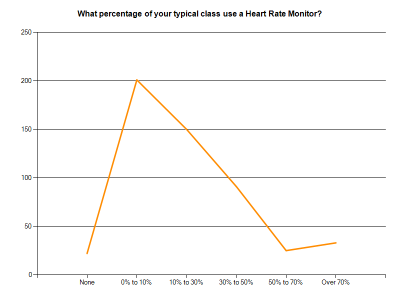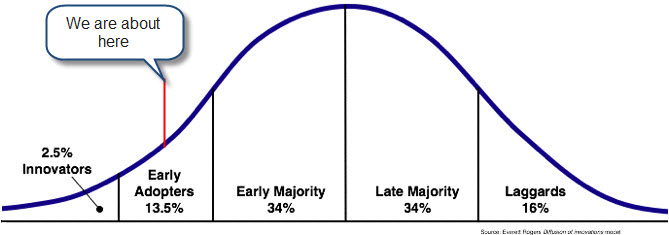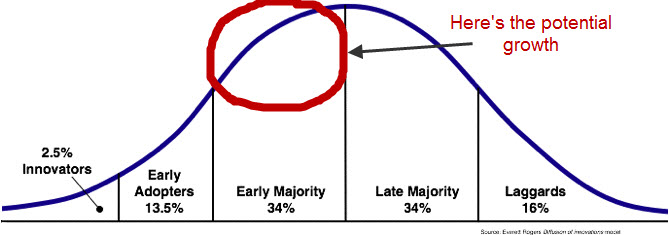Now I think we can start working on some solutions. While researching this article I learned that the the 80/20 rule is also called the Pareto principle. It's more of a rule of thumb drawn from multiple examples where roughly 80% of the effects come from 20% of the causes. Group dynamics frequently follow this rule and here's some examples:
- In business it's typical to see 80% of profits coming from only 20% of all customers.
- Inversely 80% of most complaints tend to come from about 20% of members.
- 80% of sales come from the top 20% of sales people.
- 80% of the mess at a party comes from 20% or the party-goers... and a different 20% will help clean up at the end while 80% will just watch.
Is it exact and does it apply in every situation? No
When it comes to Heart Rate Monitor usage in our classes, it looks more like 90/10.

Maybe 20% HR usage could be our goal?
This creates some interesting questions;
- Are we wasting our time promoting HR training to those who are currently not using a monitor, i.e... should we be content with 20%?
- Should we be focusing our teaching efforts on the 10%-20% who get it?
- Or should we be more focused on the 80%-90% who don't?
I don't pretend to know the answer, but I believe understanding where we are today is the first step to making changes, if any.
Each of us has to answer the first question for ourselves; are we wasting our time promoting HR training? I don't mean wasting our teaching to HR, but rather should we just stop trying to sell HR to our class?

I say no.
You may have heard the term "Tipping Point" which is illustrated above. The concept was popularized by Malcolm Gladwell in his best selling book The Tipping Point: How Little Things Can Make a Big Difference to show how different segments (or groups) of people adopt to a new concept and at what stages they are willing to do so.
The Innovators sit in the the front row, way off to one side. They can use their new Garmin HR Monitor to tell you the altitude and GPS location of their bike, in your studio, down to the nearest meter. They have the best shoes and cycling kits. They've read every book on training and are typically so focused that they aren't really following your class. If, on the slim chance they ever ask you a question, understand that it's a setup to test you. Be prepared for a debate. Your answers should often begin with "well that depends" to give yourself an out. I would put most ICI/PRO members into this group.
The Early Adopters sit front & center, watching you and the Innovators. Once they see that its safe/fun/beneficial/cool they jumped on the HR thing with both feet. You know these students by their big smiles and waving hands when you ask; "who is wearing their HR monitor today?" Some may not even know how to use their monitor, it's just important to them that they have it on. You've heard the expression "I'm as smart as the last person I talked with" ? Well these students will believe (and act) on most everything you say... and then will believe (and act) on what the next Instructor tells them. This is why I see having a common language is so important.

Scattered through the middle of your class are the Early Majority - the group that's willing to try something new, but need more than just the social proof of seeing others wearing a monitor. It took a few years and now they have cycling shoes and shorts. They're attentive, but cautious and looking for clarity from you. I feel students in the Early Majority are ready to adopt HR training if you show them a very tangible benefit, recommend a clear action and assure them that they are making a good decision.
When you see a student wearing gym trunks over his bike shorts, you should instantly think Late Majority.
The guy in the far back with a tattered T-shirt and Discount Store "fitness shoes" is a Laggard. Be thankful that he comes to class but you will never see him with a monitor.
This worked for me -
A few years ago Dave Lang, one of the Personal Trainers at the club where I teach, came to me with the idea to demonstrate a New Leaf Metabolic Assessment in front of my Sunday Endurance class. The majority of students in your class you would call cyclists are probably Early Adopters along with a few Innovators. Who better than have one of the Instructors (Innovator) show everyone exactly what happens during an assessment. I myself hadn't been tested, so I agreed.
The following Sunday Dave set up the test and connected his laptop to the big screens in the studio. Now ~40 people in class could watch in real time what was happening during my test. Dave began with a short lecture / explanation of the testing protocol and then lead me through the assessment.
Two things happened as a result:
- The Innovators in class congratulated me (I felt like I had joined their club) and wanted to compare "war stories" of their test.
- Over the next few weeks Dave scheduled and conducted over 20 assessments with students who moved into the Early Majority.
Why did this happen?
I asked a number of them later and their responses were similar. They knew they wanted the understanding that a Metabolic Assessment would bring them, but something stood in the way of taking action. It may have been some fear, concern, confusion or maybe they just needed a complete understanding of the process. Whatever it was it did the trick.

Timely post for me, John……not so much from something specific re: the HR monitors but a reminder to apply the 80:20 principle to my current situation (where, in fact, I have 00:00 interest in HR monitors)
I’m currently at a point where I’m thinking of simply dropping the classes at one of my gyms…..where the 20% appear to be roughly divided between 10% who love the class format, 10% who apparently hate it and aren’t shy about complaining that there “too much teaching”…..anonymously, of course…..and the 80% of folk who might show up once every few months. Strangely enough, this is the gym with the Keiser bikes……I’m, thinking that, if I can’t generate enthusiasm and any intellectual curiosity when the class has the power read out etc., expecting interest in HR/intensity based training is like expecting water to flow uphill.
Interestingly, one of my early experiences of HR monitor usage and metabolic assessment was under similar circumstances to your description…..I was a class member, though. Teacher was an avid triathlete and actually managed to foster an “athletes in training” mentality among most of us…..and I guess that HR monitor usage was close to 100%
He arranged for two trainers who did metabolic assessments to come to the gym and we had a whole Sunday am of testing. I fancy most everyone signed up…..reducing the cost for all of us…..and putting pretty much all of us into that left hand “outlyer” section of your Bell-curve illustration.
Had to laugh, though as next class was a mix of pi$$ing contest and excuse making……some folk treating their VO2Max like is was some sort of personal value judgement rather than a training tool.
Thanks for the memory jogger,
Vivienne